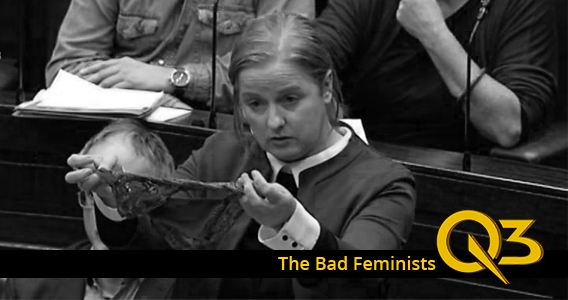by Victoria Araujo
A 27-year-old man, accused of raping a 17-year-old in a muddy alleyway was found not guilty by a jury at the Central Criminal Court in Cork. The jury consisted of eight men and four women taking one and a half hours to deliberate, reaching a unanimous verdict.
The case which made headlines in the UK and abroad, sparked protests in Dublin, Cork and Limerick after a defence lawyer said in the closing argument, ÔÇÿyou have to look at the way she was dressed.ÔÇÖ He said: ÔÇÿShe was wearing a thong with a lace frontÔÇÖ. As a result of the tone of this discourse, thousands of women also shared their underwear images on Twitter, using the hashtag #thisisnotconsent.
According to The Irish Examiner, the defence lawyer emphasised the alleged rape was consensual, contradicting the complainant who affirmed in court she was raped. When the accused was cross-examined by Tom Creed SC for the prosecution,┬áhe said they ÔÇÿfelt attracted to one another on the nightÔÇÖ, to which Mr Creed replied: ÔÇÿThere is not one person who saw you kissing.ÔÇÖ The defendant named one man who allegedly did see them kissing, although such person did not present any evidence in the trial.
When the prosecution asked the defendant to describe the sexual encounter, he said they were lying down in a muddy area. He claimed he could not get fully erect, therefore while penetration was possible, he thought it was unlikely.
Mr Creed also pointed out how a witness saw him with his hand to her throat, but the accused said such situation was misread. The defendant also denied dragging her 30 metres to the spot where the alleged rape took place, claiming the 17-year-old was worried about her dress getting dirty.
He said that when someone at the scene asked if everything was alright, in which he claimed to be in a sarcastic manner, he responded saying: ÔÇÿWhat the f*ck does it look like. Mind your own business.ÔÇÖ
ÔÇÿThen she (the complainant) was getting funny, it was like she snapped out of a buzz. She said stop and I stopped. We were going to have sex, she said stop and I stoppedÔÇÖ, he testified in court.
The prosecution said to the jury in a final statement: ÔÇÿYou decide if there was sexual intercourse between them. You decide if there was consent.
ÔÇÿYou have heard her say she did not consent. You have heard him say she did consent. The major issue you have to deal with is whether she consented to sexual intercourse. It is one way or the other. Either she did or did not. If you are satisfied she did not consent and that he knew she did not consent then you convict.
ÔÇÿShe is quite clear she did not consent. She said she never had sexual intercourse before.
ÔÇÿIt has been alleged by the defendant there was lots of kissing going on. In terms of kissing there is not one witness in this case who can say they were kissingÔÇÖ.
Mainstream media emphasised the trial, both in the UK and abroad. The Guardian headlined: ÔÇÿNorthern Ireland rape case review calls for legal representation for complainantsÔÇÖ. The Times emphasised the public outraged for the way the underwear was being cited by the defence in the rape trial. Similarly, The New York Times headlined, ÔÇÿLawyer in Rape Trial Links Thong With Consent, and Ireland EruptsÔÇÖ.
Meanwhile, in the Irish Parliament chamber, MP Ruth Coppinger told officials how things such as clothing, fake tans and contraceptives ÔÇ£have recently been used to discredit women who had the bravery to go to court.ÔÇØ She said: ÔÇ£The women of this country are getting a little weary at the routine victim-blaming going on in Irish courts, and the failure of lawmakers in this House to do anything about it.ÔÇØ┬á
After Ruth Coppinger’s comments and her demonstration of underwear in the chamber, to illustrate her argument, women shared photos of their underwear to protest the comments made at the rape trial about the girlÔÇÖs underwear. The pictures, which went viral worldwide, were posted to strengthen the idea that it does not matter what kind of underwear a woman chooses to wear, it does not imply consent.
In 2002, parents of a rape victim, Linda Armstrong and Frank Ferguson, from Ayrshire, found their daughter, Lindsay Armstrong, dead in her room. They said she felt “raped all over again” during the trial, as she felt ÔÇ£humiliated and degradedÔÇØ. According to The Telegraph, recently Ms Armstrong said she was┬áÔÇÿ‘appalled’ÔÇÖ by this new case, with the girl’s thong being used against her in the Irish court. Both cases point out to how the treatment to alleged rape victims did not change over a decade.
This trial, which some say was justified by victim blaming, highlighted the defaults of the court system, one which doesnÔÇÖt treat the alleged victim with the sensitivity such case calls for. While it is not the first time an underwear is taken for examination in a trial, as the case of Lindsay Armstrong shows, the way the presentation of ÔÇÿevidenceÔÇÖ was dealt with in this trial points out how such system calls for a change.
After the controversy caused by this case in Cork, retired appeal court judge Sir John Gillen was tasked with conducting a review of how the criminal system in Northern Ireland deals with cases of serious sexual offences, according to The Independent.
While some might say that due to the nature of this case, debates on social media should be avoided to keep the anonymity of the victim, as well as the integrity of the case, it is possible to argue that in this circumstance the debate was about an argument presented in court, one which certainly attaches the idea of being open to sex to someoneÔÇÖs type of underwear.
The trouble about such an argument is, a thong canÔÇÖt speak or represent someoneÔÇÖs intentions, or what they want or do not want to do. What someone said (before and during) should always speak louder than anything else, instead of what someone wears.┬á No means no. It shouldnÔÇÖt matter if youÔÇÖre topless, braless, wearing a full covered piece of clothing or not. ┬áWords should play a role, not someoneÔÇÖs clothing choices, because if it does, then we truly take away peopleÔÇÖs voices, and especially womenÔÇÖs.










